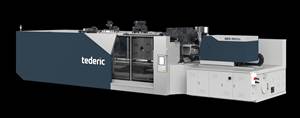Pushing the Limits in Overmolded RFID Tags
Processor Strategies
Startup molder devises new techniques for RFID tags.
Thanks to a new engineering resin and proprietary injection overmolding technique, Xtreme RFID in Grand Rapids, Mich., is producing one-piece, fully encapsulated RFID tags for asset tracking. Only two years old, Xtreme RFID was created as a new unit of Cascade Engineering, a multifaceted custom and proprietary molder, also based in Grand Rapids. Cascade had encapsulated RFID chips for municipal solid-waste bins since 2006 and formed the new unit to focus on this emerging business and technology.
Mike Lewis, business leader of Xtreme RFID, describes the new operation as “a small startup.” It has 10,000 ft2 of space, two injection machines of 100 and 250 tons, and four full-time employees. As for the market, Lewis says,“We’re still in the early adopter phase. But nearly every industry is developing the capability for RFID tags. Retail is the leader, along with medical and oil-and-gas industries.”
Xtreme RFID differs from most of its competition, which molds two-piece plastic casings and glues or sonic welds them together around the RFID tag. “That’s less rugged than what we do,” says Lewis. Insert molding the tag into a single piece of plastic provides the highest possible protection from water and chemicals. A coating over the electronic chip in the tag protects it from contact with the hot plastic. Still, preserving the electronics from damage by the heat and pressure of molding is the essence of the firm’s proprietary two-shot technique. Only a few other molders have tried this challenging route of one-piece overmolding (one other was discussed in a Close Up story last month).
The latest Xtreme RFID product is the Allied Series VX-Mid HT ultra-high-frequency (UHF) RFID tag for direct mounting on metal inventory. The Allied Series utilizes ViziCore RFID tags from Vizinex RFID of Allentown, Pa., as well as a new Fortron PPS compound from Celanese Corp., Florence, Ky. PPS offers high heat and chemical resistance (protection against fuels, oils, and solvents), as well as high mechanical strength for uses in harsh environments such as oil and gas industries, mining, commercial fishing, municipal solid-waste recovery, and general manufacturing.
The material is Celanese’s new Fortron ICE (Improved Crystallization Evolution) PPS, which is designed to crystallize at higher temperature than standard PPS, resulting in faster and more complete crystallization at lower temperatures and a finer, more uniform crystallite structure. Introduced at the last fall’s K 2013 show in Germany, Fortron ICE allows for as much as 33% faster cycles in complex parts, lower mold temperatures (allowing for hot-water instead of oil mold-temperature control), and improved demolding of complex parts with less breakage.
And these benefits are said to come with virtually no change in finished part properties compared with standard PPS grades. (Fortron ICE was the subject of a paper by Celanese’s Dr. Ke Feng at last month’s SPE ANTEC in Las Vegas.)
Xtreme RFID is using Fortron ICE 716A (65% glass and mineral filled). Lewis says it allows his molds to run at 100 C instead of the usual 200-210 C, cutting cycle time, which helps the RFID tags survive contact with 650 F melt temperature. “Before this, the high temperature was killing the chips,” Lewis notes.
Xtreme RFID has another version of the Allied Series tag in PP, but the firm can encapsulate tags in 10 different resins, including nylon, PE, TPV, TPU, and TPE.
Related Content
Secondary Injection Unit Provides Primary Benefits for Molder
Core Technology Molding turned to Mold-Masters E-Multi auxiliary injection unit to help it win a job and dramatically change its process.
Read MoreMilacron’s Massive Booth Highlights Multiple Brands
NPE2024: Coinjection of postconsumer resin, in-mold decoration, LSR micromolding and bioplastics processing are just some of the machine displays at Milacron's booth.
Read MoreTederic Promotes High Technology, Broader Market Presence
Four cells are running in its booth including a 1,300-ton multimaterial system highlighting its 2K capabilities.
Read MoreElectric Injection Molding Machine Line Expands
Boy will debut three new models in its Electric series of machines, which feature a redesigned and more compact drive and inverter technology.
Read MoreRead Next
Beyond Prototypes: 8 Ways the Plastics Industry Is Using 3D Printing
Plastics processors are finding applications for 3D printing around the plant and across the supply chain. Here are 8 examples to look for at NPE2024.
Read MoreSee Recyclers Close the Loop on Trade Show Production Scrap at NPE2024
A collaboration between show organizer PLASTICS, recycler CPR and size reduction experts WEIMA and Conair recovered and recycled all production scrap at NPE2024.
Read MoreMaking the Circular Economy a Reality
Driven by brand owner demands and new worldwide legislation, the entire supply chain is working toward the shift to circularity, with some evidence the circular economy has already begun.
Read More















